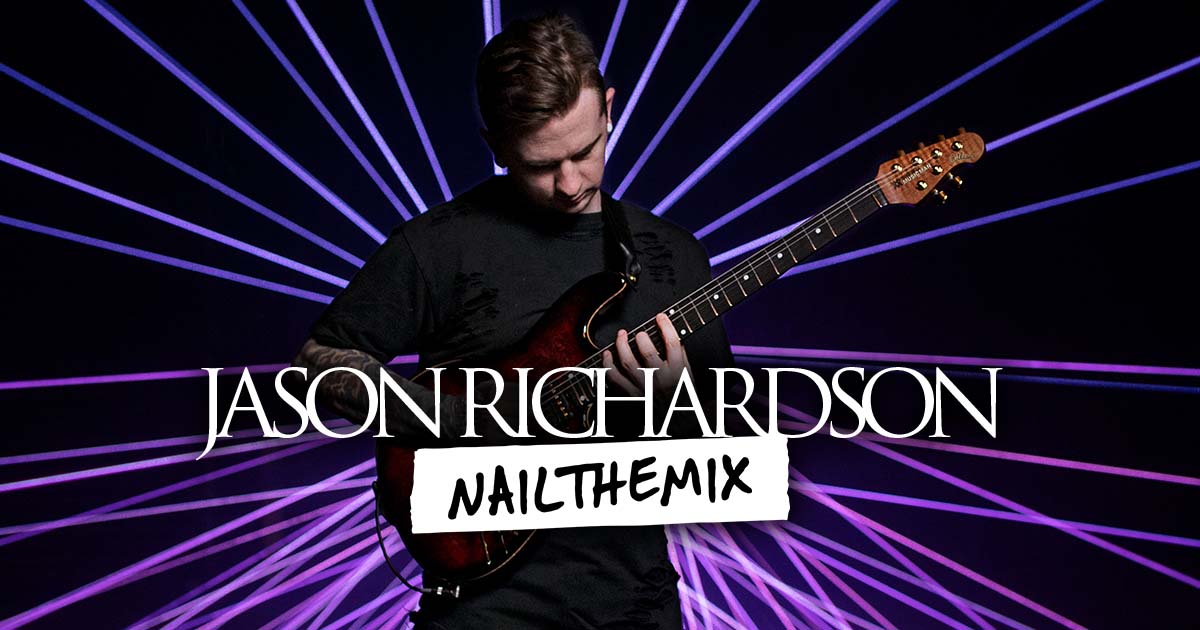
How To Use Automation On Metal Guitars And Bass
Nail The Mix Staff
Let’s be honest, a metal mix that just sits there, flat and unchanging, is a recipe for a skipped track. You want those riffs to pummel, those choruses to soar, and those breakdowns to absolutely crush. One of the most powerful ways to inject this life and energy into your metal productions is through volume automation, especially on your guitars and bass. We’re diving into how Joel Wanasek (Unstoppable Recording Machine, Nail The Mix) uses this fundamental tool to make tracks like Machine Head’s “Is There Anybody Out There?” explode out of the speakers.
Forget just setting static levels and calling it a day. If you want your metal mixes to truly connect and tell a story, automation is your best friend.
Why Your Metal Mix Needs Volume Automation
Think about your favorite action movie. It’s not just two hours of non-stop explosions, right? There are moments of quiet tension, rising action, huge climactic scenes, and then periods to catch your breath. A great song, especially a dynamic metal track, should take the listener on a similar journey.
Volume automation is how you, the mix engineer, become the director of this sonic movie. You’re guiding the listener’s emotions, creating suspense before a massive riff drops, making a chorus feel bigger than life, and ensuring those intricate little details don’t get lost. A static mix is like a movie where every scene has the same intensity – pretty boring, and you’d probably be wondering what the point was by the end. By automating volume, you create those essential ups, downs, and even sideways movements that make a song engaging and memorable.
Getting Started: Prepping for Guitar & Bass Automation
Before you start drawing in automation curves like a caffeinated artist, it’s crucial to have a solid foundation. This means your basic mix should already be in a good place. Your guitars (whether they’re quad-tracked with DI bombs blended in, or a simpler setup) and your bass (often split into low-end and grit tracks, then bussed) should have their core tones dialed in with EQ and levels that are generally balanced.
If you’re still working on carving out space and defining those instrument tones, learning how to balance metal guitars and bass in a mix is a critical first step. Once that’s sorted, you’re ready to bring in the dynamic magic with automation.
Core Volume Automation Moves for Guitars and Bass
Alright, let’s get into the nitty-gritty. Using the Machine Head track as a guide, here are some key automation techniques Joel Wanasek employs to make guitars and bass come alive. These are all about enhancing sectional dynamics and making specific parts hit with intention.
Building Anticipation: Intro and Buildup Dynamics
That massive buildup before the first riff hits? It needs to feel like it’s actually building.
- Pull Back Before the Punch: In the intro section of “Is There Anybody Out There?”, Joel slightly brings down the rhythm guitars and bass during the initial buildup. This creates more headroom and contrast, so when the main riff kicks in, it feels significantly larger and more impactful.
- Subtle Crescendos: For elements like guitar harmonics or sustained notes leading into a new section, a gentle volume swell can create a smoother, more exciting transition. Draw in a slight increase in volume right up to the downbeat of the next part.
Maximizing Impact: Instrumental Riffs and Heavy Sections
When the vocals drop out and it’s time for the guitars to take center stage, automation helps them command attention.
- Guitar Power-Up: For main instrumental riffs, don’t be afraid to push the guitars up a dB or two. This ensures they feel big and powerful, especially if there are no vocals competing for space.
- Strategic Bass Presence: The bass usually follows the guitars, but you might keep it relatively stable here unless a specific bass accent needs to pop. The goal is guitar dominance in these moments.
Verse Control: Letting Vocals Shine While Guitars Punch
Verses often carry the lyrical narrative, so clarity is key.
- Balanced Guitars: Guitars should be present and provide energy, but not so loud that they overshadow the vocals. Find a level that feels supportive.
- Taming Sustains: If sustained guitar chords or notes start to “bloom” and poke out too much, especially when other elements like strings or tom fills are introduced, automate them down slightly to maintain an even texture. For persistent boominess in the low-mids, another advanced approach is to use multiband compression to control low-end on metal guitars, which tames problem frequencies only when they appear.
- Filling the Gaps: Sometimes, a quick, small boost to the guitars in the gaps between vocal phrases can add energy without cluttering the vocal delivery.
Monster Choruses: Using Bass and Guitar Automation
The chorus is usually the peak emotional point of the song – it needs to feel huge!
- Bass Boost for Weight: One of Joel’s go-to moves for a harder-hitting chorus is to automate the bass guitar up. This adds weight and power, making the chorus physically kick harder. This often involves boosting both the low-end and the grit/distortion tracks of the bass. That aggressive grit is often created by using guitar amp sims on the bass DI, which helps it cut through.
- Prioritizing Vocals & Melody: In a big, radio-friendly chorus (like in the Machine Head example, which charted), the vocals and main melodic elements (like strings) are often king. If guitars have intricate licks or harmonics happening, consider subtly automating them down if they become distracting. You still want to hear them, but they shouldn’t pull focus from the main vocal melody.
- Pro Tip: While volume is key, the overall punch of a chorus often benefits from smart bus processing. Exploring a technique for super aggro mix bus compression can add that final layer of power and glue.
Highlighting Ear Candy: Fills, Harmonics, and Unique Licks
Those cool little moments in the track? Make sure people hear them!
- Guitar Boosts on Fills: When the drummer throws in a tasty fill, the transients can sometimes mask the clarity of the guitars. A tiny, quick volume bump on the guitars during the fill can help them cut through and maintain presence.
- Spotlighting Harmonics: Got some killer pinch harmonics or screaming feedback? Automate their volume up to make them leap out of the mix. This was done effectively on some pinch harmonics in the Machine Head track to make them really sizzle.
- Accentuating Bass Lines: If the bassist throws in a cool slide or a unique melodic run (like the bass slides at the end of the Machine Head song), give it a momentary volume lift to draw the listener’s ear. This is especially effective when a part has been heard multiple times; a small change keeps it interesting.
Crushing Breakdowns and Bridges: Pushing the Limits
When it’s time to get HEAVY.
- Serious Bass Power: For breakdowns or super heavy bridge sections, don’t be shy about significantly boosting the bass. This could be the overall bass bus, or you might focus on boosting the “grit” track of the bass to add aggression and perceived loudness without necessarily making the sub-lows overwhelming. This is a perfect way to get that clanky metal bass tone that helps it slice through even the densest guitar wall. Joel demonstrates a hefty bass boost in a heavy section of the Machine Head track to make it sound massive.
- Maintaining Guitar Definition: While the bass is getting a boost, ensure your guitars still have their power and definition. They might not need as much of a lift if the bass is doing the heavy lifting in terms of sheer size.
Smooth Exits: Automation for Outros and Fades
How a song ends is just as important as how it begins.
- Controlled Fades: Use volume automation to create smooth, natural-sounding fade-outs on your guitar and bass buses.
- Punchy Final Hits: For songs with big, final stabs, you can automate the bass grit (and guitars) up on those last hits for extra punch and impact before the silence.
Pro Automation Workflow: Tips from the Trenches
Writing automation can seem daunting, but a few workflow habits can make it much more manageable and effective:
- Trust Your Ears, Not Just Your Eyes: The automation lanes in your DAW are a guide, but what sounds right is what matters. Close your eyes and listen.
- Section by Section: Tackle automation in chunks. Get the verse feeling good, then the chorus, then the bridge. Don’t try to automate the whole song in one pass.
- Copy & Paste is Your Friend: If a section repeats (like a second verse or chorus), copy the automation you’ve already dialed in for the first instance and paste it. You can then tweak it if needed. This saves a ton of time.
- Small Moves, Big Impact: Often, a 1-2 dB change is all you need to make a part feel significantly different. Don’t go overboard unless the song calls for extreme dynamics.
- Compare and Contrast: Regularly bypass your automation to remind yourself of the static mix. This helps you appreciate the changes you’re making and ensure they’re actually improving the song.

100+ Insanely Detailed Mixing Tutorials
We leave absolutely nothing out, showing you every single step
Taking Your Metal Mixes to the Next Level with Nail The Mix
Mastering volume automation for guitars and bass is a massive step towards dynamic, professional-sounding metal mixes. As Joel Wanasek demonstrates, these techniques can transform a good mix into a great one by telling a more compelling sonic story.
But what if you could see exactly how producers like Joel, Eyal Levi, and Joey Sturgis apply these concepts – and many more – to real songs from bands like Gojira, Periphery, and Meshuggah? That’s what Nail The Mix is all about. Every month, you get the actual multi-tracks from a killer song and watch the original producer mix it from scratch, explaining every decision, every plugin, and every automation move.
If you’re ready to go beyond basic tutorials and learn the intricate details that make a professional metal mix shine, it’s time to Unlock Your Sound and start mixing modern metal beyond presets. You’ll gain access to a treasure trove of knowledge, exclusive plugins, and a community of like-minded producers.
So, start experimenting with volume automation on your next metal project. Listen critically to how different parts of the song feel, and use automation to enhance that feeling. You’ll be surprised at how quickly your mixes start to breathe and punch with new life. Happy automating!
Get a new set of multi-tracks every month from a world-class artist, a livestream with the producer who mixed it, 100+ tutorials, our exclusive plugins and more
Get Started for $1





